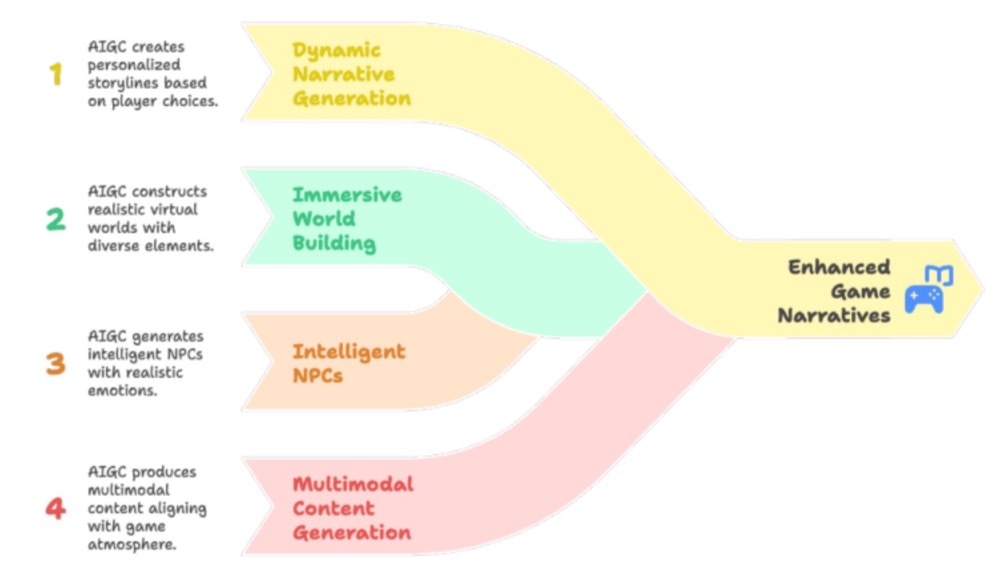Innovative Applications of AIGC Technology in Game Narratives
DOI:
https://doi.org/10.71113/JMSS.v2i4.350Keywords:
Artificial Intelligence Generated Content (AIGC), Game Narratives, Immersive Experience, Interactive NarrativesAbstract
With the rapid advancement of Artificial Intelligence Generated Content (AIGC) technology, the field of game narratives is undergoing a revolutionary transformation. This paper explores how AIGC technology is innovatively applied to game narratives, offering players unprecedented immersive experiences. It begins by outlining the fundamental principles of AIGC and its potential in narrative creation. Subsequently, it delves into key innovative applications of AIGC in game narratives, including automated script generation, interactive character development, dynamic environment construction, and personalized narrative experiences. Despite the immense potential of AIGC in game narratives, this paper also highlights challenges such as technological maturity, narrative coherence, ethical and privacy concerns, and audience acceptance. Finally, it proposes solutions and future research directions to promote the further development and application of AIGC in game narratives.
References
Begemann, A., & Hutson, J. (2025). Navigating copyright in AI-enhanced game design: Legal challenges in multimodal and dynamic content creation. Journal of Information Economics , 3 (1).
https://doi.org/10.58567/jie03010001
Cao, X., & Duan, J. (2024). Research on technology application and technology innovation efficiency of digital media company based on AIGC technology and DEA model. In Proceedings of the 2024 4th International Symposium on Big Data and Artificial Intelligence (pp. 29-34).
https://doi.org/10.1145/3723366.3723371
Chamola, V., Sai, S., Bhargava, A., Sahu, A., Jiang, W., Xiong, Z., Niyato, D., & Hussain, A. (2024). A comprehensive survey on generative AI for metaverse: Enabling immersive experience. Cognitive Computation , 16 (6), 3286-3315.
https://doi.org/10.1007/s12559-024-10342-9
Chen, H., Chen, Y., Zhu, Z., & Zhang, Y. (n.d.). Towards the engine cinema: The virtual production in Chinese film industries. In The screens of virtual production (pp. 283-298). Routledge.
https://doi.org/10.4324/9781003463139-23
Foo, L. G., Rahmani, H., & Liu, J. (2025). AI-generated content (AIGC) for various data modalities: A survey. ACM Computing Surveys , 57 (9), 1-66.
https://doi.org/10.1145/3728633
Hu, Z., Ding, Y., Wu, R., Li, L., Zhang, R., Hu, Y., Qiu, F., Zhang, Z., Wang, K., Zhao, S., et al. (2023). Deep learning applications in games: A survey from a data perspective. Applied Intelligence , 53 (24), 31129-31164.
https://doi.org/10.1007/s10489-023-05094-2
Inbavalli, A., Sakthidhasan, K., & Krishna, G. (2024). Image generation using AI with effective audio playback system. In 2024 5th International Conference for Emerging Technology (INCET) (pp. 1-13). IEEE.
https://doi.org/10.1109/INCET61516.2024.10593387
Kumar, P. (2024). Large language models (LLMs): Survey, technical frameworks, and future challenges. Artificial Intelligence Review , 57 (10), 260.
https://doi.org/10.1007/s10462-024-10888-y
Kumaran, V., Rowe, J., Mott, B., & Lester, J. (2023). SceneCraft: Automating interactive narrative scene generation in digital games with large language models. In Proceedings of the AAAI Conference on Artificial Intelligence and Interactive Digital Entertainment (Vol. 19, pp. 86-96).
https://doi.org/10.1609/aiide.v19i1.27504
Li, X., Fan, Y., & Cheng, S. (2023). AIGC in China: Current developments and future outlook. arXiv preprint arXiv:2308.08451 .
Lim, M. Y., Dias, J., Aylett, R., & Paiva, A. (2012). Creating adaptive affective autonomous NPCs. Autonomous Agents and Multi-Agent Systems , 24 , 287-311.
https://doi.org/10.1007/s10458-010-9161-2
Liu, Q., Li, J., & Hu, W. (2025). Exploration of cross-modal AIGC integration in Unity3D for game art creation. Electronics , 14 (6), 1101.
https://doi.org/10.3390/electronics14061101
Lou, Y. (2023). Human creativity in the AIGC era. She Ji: The Journal of Design, Economics, and Innovation , 9 (4), 541-552.
https://doi.org/10.1016/j.sheji.2024.02.002
Pan, Z., Yu, W., Yi, X., Khan, A., Yuan, F., & Zheng, Y. (2019). Recent progress on generative adversarial networks (GANs): A survey. IEEE Access , 7 , 36322-36333.
https://doi.org/10.1109/ACCESS.2019.2905015
Song, Y., & Xiong, W. (2025). Large language model-driven 3D hyperrealistic interactive intelligent digital human system. Sensors , 25 (6), 1855.
https://doi.org/10.3390/s25061855
Wang, X., Hong, Y., & He, X. (2024). Exploring artificial intelligence generated content (AIGC) applications in the metaverse: Challenges, solutions, and future directions. IET Blockchain , 4 (4), 365-378.
https://doi.org/10.1049/blc2.12076
Xiang, P., Wei, M., Liu, H., Wu, L., & Qi, J. (2024). How does technological value drive 6G development? Explanation from a systematic framework. Telecommunications Policy , 48 (7), 102790.
https://doi.org/10.1016/j.telpol.2024.102790
Xu, M., Du, H., Niyato, D., Kang, J., Xiong, Z., Mao, S., Han, Z., Jamalipour, A., Kim, D. I., Shen, X., et al. (2024). Unleashing the power of edge-cloud generative AI in mobile networks: A survey of AIGC services. IEEE Communications Surveys & Tutorials , 26 (2), 1127-1170.
https://doi.org/10.1109/COMST.2024.3353265
Yang, L., Zhang, Z., Song, Y., Hong, S., Xu, R., Zhao, Y., Zhang, W., Cui, B., & Yang, M.-H. (2023). Diffusion models: A comprehensive survey of methods and applications. ACM Computing Surveys , 56 (4), 1-39.

Downloads
Published
How to Cite
Issue
Section
License
Copyright (c) 2025 Yue Wu

This work is licensed under a Creative Commons Attribution 4.0 International License.


























